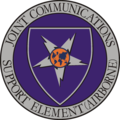
The Joint Enabling Capabilities Command (JECC) is a subordinate command of United States Transportation Command, headquartered at Naval Station Norfolk, Virginia. It was previously part of United States Joint Forces Command. It developed from the Standing Joint Force Headquarters concept trialed during Exercise Millennium Challenge 2002. [1]
Contents
Its mission is to provide expeditionary joint command and control (C2) enabling capabilities (joint planners, public affairs specialists, and communications) to Combatant Commanders (CCDRs) globally, for the rapid establishment of Joint Force Headquarters (JFHQ) in competition, crisis, and conflict..
Its two elements provide capabilities across seven unique functional areas. It aims to bring these packages to a joint force commander within hours of notification. The JECC subordinate commands are:
- The Joint Planning Support Element (JPSE) – Provides rapidly deployable, tailored, ready, joint planners, operators, logisticians, knowledge managers, and intelligence specialists in order to accelerate the formation and increase the effectiveness of newly formed joint force headquarters. JPSE also provides ready, rapidly deployable, joint public affairs capabilities to combatant commanders in order to facilitate rapid establishment of joint force headquarters and bridge joint public affairs requirements. JPSE is co-located with the JECC headquarters at Naval Station Norfolk, Virginia.
- The Joint Communications Support Element (Airborne) (JCSE) – Provides rapidly deployable, en route, early entry and scalable command, control, communications, computer, intelligence, surveillance and reconnaissance (C4ISR) capabilities across the full spectrum of operations in order to facilitate rapid establishment of joint force headquarters and bridge joint C4ISR requirements. JCSE is located at MacDill Air Force Base, Florida.









